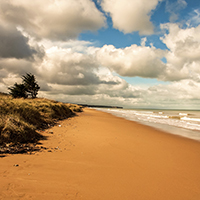Viewpoint: D-Day dogs and other animals of war
Published on
 Dr Chris Pearson is a Senior Lecturer in Twentieth-Century History in the University of Liverpool's Department of History
Dr Chris Pearson is a Senior Lecturer in Twentieth-Century History in the University of Liverpool's Department of History
"As reported in a recent Spiegel International article, the British army parachuted dogs onto French soil to locate mines and booby traps during the D-Day landings. This episode highlights how armies still relied on animals just as they had done during the First World War, despite the highly mechanized character of warfare between 1939 and 1945.
"Although we might think of war as a strictly human affair, animals posed numerous possibilities and problems during the Second World War
Horse-borne units
"In 1939 and 1940, France and Germany both deployed horses to support their combat units. Amongst its horse-borne units, France had three Spahi brigades and five light cavalry divisions, while two-thirds of its artillery units were drawn by horsepower.
"On the German side, the majority of infantry units still relied on horses for transportation, despite the image of technologically advanced Blitzkrieg tactics. As horses became exhausted during the rapid German advance through France, German units requisitioned French military and civilian horses.
"Between 22 June and 30 June 1940 the 218th Infantry division seized 9,000 French horses and by 1 August 1940, 34,000 requisitioned horses had arrived in Germany from Belgium, Holland and France.
[callout title= ]"The British were not the only ones to exploit the possibilities offered by pigeons: by the end of the war the US Army Pigeon Service reportedly boasted 55,000 birds"[/callout]"Germany also mobilized hundreds of thousands of horses on the Eastern Front. In 1942 the Wehrmacht had 400,000 horses under its control for its invasion of the USSR, using them to pull arterially pieces and other matérial.
"Pigeons too were pressed into service as ‘feathered messages’. The British Royal Air Force established a Pigeon Section with some RAF bomber crews carrying pigeons to fetch help in the event of an emergency.
"Pigeons were also used to liaise with secret agents and resistance groups in France. The British were not the only ones to exploit the possibilities offered by pigeons: by the end of the war the US Army Pigeon Service reportedly boasted 55,000 birds.
"Whilst armies mobilized animals to wage war, they also mobilized against them. US armed forces led a sustained campaign against malaria-carrying mosquitoes in the Pacific. Initial malaria control measures were weak. Malaria epidemics and depleted fighting power were the result: in the early stages of the war, malaria caused eight to ten times more casualties amongst US forces than Japanese troops achieved in battle.
"In 1943 General Douglas MacArthur took matters in hand, ordering the deployment of malaria control units, the use of prophylactic drugs, such as quinine, and better education for troops. The measures paid off and by June 1944 the malaria rate amongst troops had dropped by 95 per cent.
[callout title= ]"Within the logic of totalizing warfare, US entomologists developed new technologies to annihilate lice and mosquitoes, including DDT spraying. The use of DDT is one of the war’s most profound environmental and social legacies, remaking ecosystems and human DNA"[/callout]"Within the logic of totalizing warfare, US entomologists developed new technologies to annihilate lice and mosquitoes, including DDT spraying. The use of DDT is one of the war’s most profound environmental and social legacies, remaking ecosystems and human DNA.
"On the home front, civilian attempts to control nonhuman pests were widespread. Insects and rodents threatened vital national resources, particularly food supplies. The British government mobilized against rabbits, rats and other rodents that threatened agricultural output.
"Measures included the Rabbits Order of October 1939 (no. 1493), which empowered County War Agricultural Executive Committees to destroy rabbits deemed harmful to crops. Scientists joined the fray. The leading light of animal ecology in Britain, C. S. Elton, secured funding from the Agricultural Research Council to allow his Bureau of Animal Population to develop the most effective way of killing rats, rabbits, and mice.
"The demands of totalizing warfare led to new knowledge about Britain’s rodents and new policies against them. Having conducted surveys of mouse and rat populations, the Bureau perfected its technique of delivering poisoned bait using a range of experimental methods, including infra-red photography.
Annihilate whole species
"Elton and others pushed for more effective and closely-managed pest control to be extended into peacetime, principally through the Prevention of Damage by Pests Act (1949). As with DDT, wartime pest control in Britain aimed to use scientific knowledge and new technologies to annihilate whole species with lasting legacies for the postwar period.
"Parachuting D-Day dogs therefore point the way to a far more extensive animal presence during the Second World War. Animals played important roles as combat auxiliaries and as pests and disease carriers.
"Combatant nations treated them as both allies and enemies during the war, meaning that the wartime relationship between humans and animals was marked by complexities and contradictions."
[callout title=More]Becoming an Expert: Michael Robinson on the treatment of Irish Great War participants[/callout]
